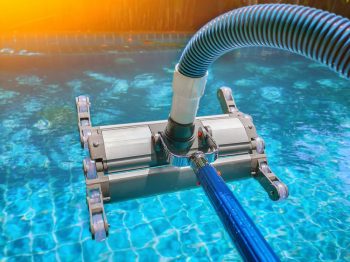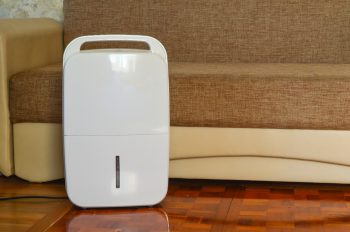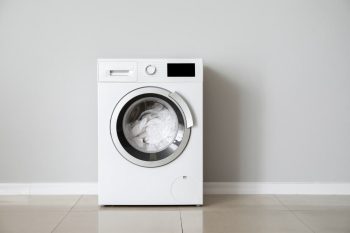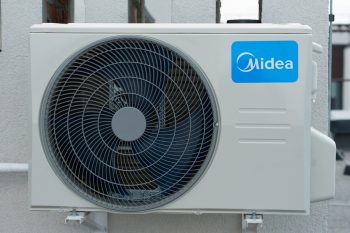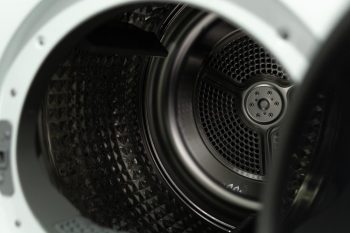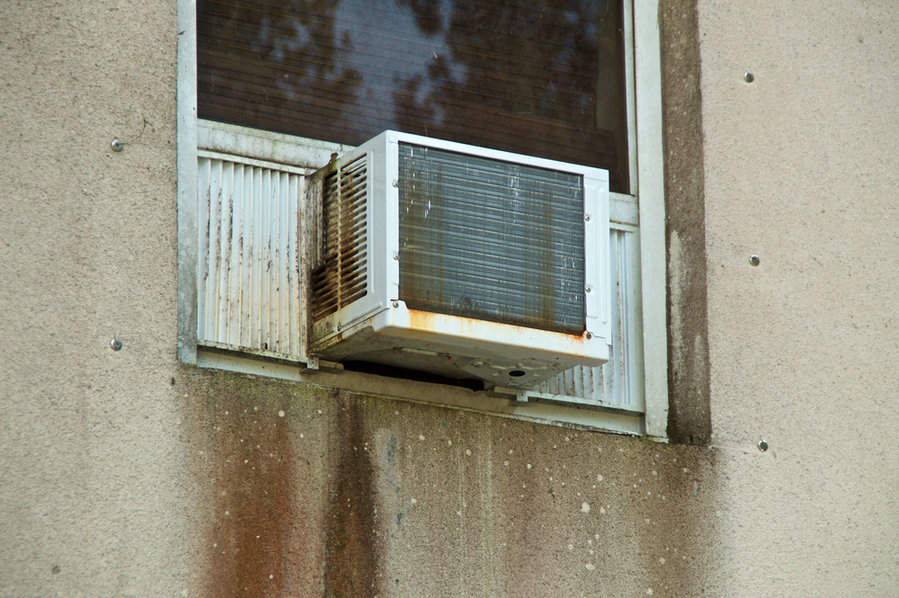
Birds love warm, shaded, secure places to build nests, lay eggs, and raise their young ones. Outdoor and window AC units offer these ideal conditions for birds to nest.
However, while they mean no harm, they can cause damage to the AC unit, reducing its efficiency. YouTherefore, you must remove bird nests from your AC unit when you immediately see them.
Additionally, it would be best to put measures in place to prevent them from returning. Luckily, there are many ways through which you can achieve this.
- Birds are drawn to build nests in AC units due to the shade, warmth, and safety that condenser units or window AC units provide.
- A nest in an AC is dangerous because the materials on the nest can damage AC fan blades, cause fires, or clog the evaporator coils, filters, and condensate pipes.
- Additionally, bird feathers may contain bacteria and germs which can enter your home, causing illnesses.
- If a nest has eggs or a brooding mother bird, it is best to contact the local bird rescue organization to handle it.
- If the nest is empty, you can remove it, ensuring you wear protective attire and later disinfect the area where it was.
- To prevent birds from nesting on the AC again, consider implementing protective measures such as sealing gaps in your AC, installing bird spikes, using bird repellants, using scare models, and installing wire mesh around the AC.
This article discusses the effects of having a bird’s nest in your AC unit. We’ll also discuss removing a bird’s nest from your AC and tips for keeping birds and other animals from the unit.
Effects of Having Bird Nests in Your AC
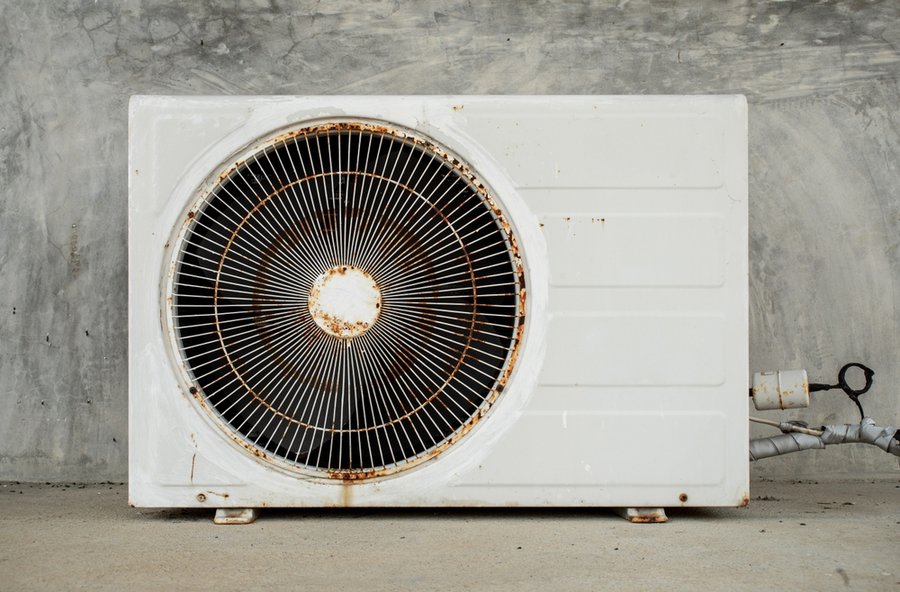
Before we delve into removing a bird’s nest from your AC, it is vital to understand the negative effects a bird’s nest can have on your AC and your home’s air quality.
They include the following:
- Birds can damage the insulation on the refrigerant pipes, which can reduce their efficiency, and therefore the AC will be ineffective in cooling your home.
- Birds use twigs, dry grass, and straws, which are highly combustible. This poses a fire hazard for your home because, in case of a short circuit in the AC, the nest can easily catch fire, which can spread to the rest of your home.
- The materials that birds use to build nests, such as twigs, can get stuck inside the fan blades, stopping them from rotating properly. This affects AC efficiency and leads to expensive repairs. In addition, the twigs can result in the AC making clicking noises.
- Birds’ feathers and droppings contain dangerous germs, mites, ticks, and bacteria. When a nest is on an AC, these microorganisms can find their way into your indoor air, causing severe illnesses to your family.
- Bird feathers and nesting materials can clog the evaporator coils, AC filters, and condensate pipes leading to AC inefficiency.
Removing a Bird’s Nest From Your AC
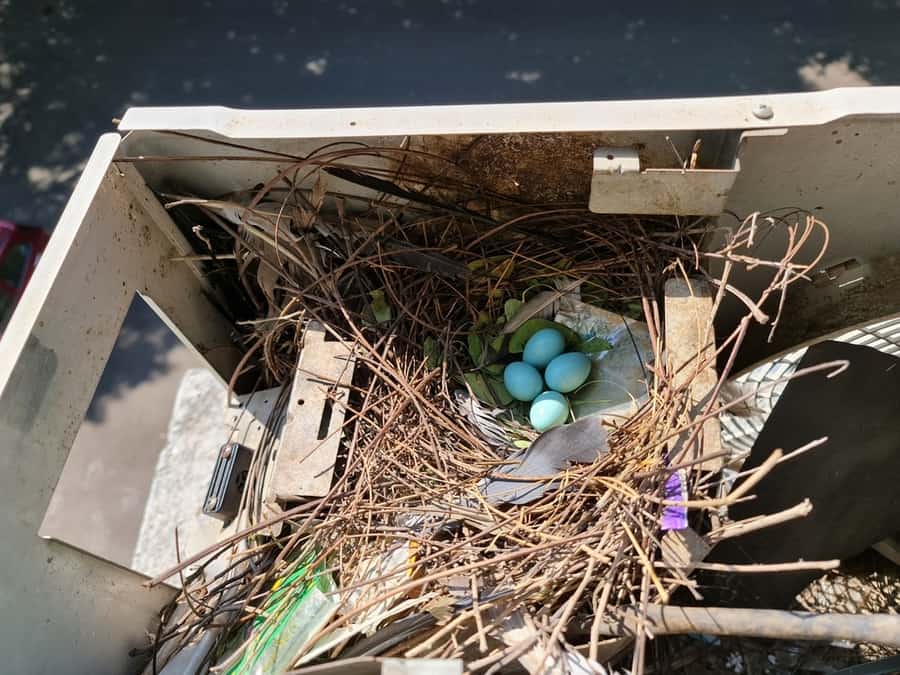
Window air conditioners and AC condenser units provide the required warmth, shade, and safety for birds to build nests and lay eggs, especially when air conditioners are inactive.
Unfortunately, once you start using the AC, the birds are at risk of electrocution, and they can also cause severe damage to components of the AC, such as the motor and fan blades. Therefore, the best time to remove the nest is before its completion.
Unfortunately, in most cases, you’ll notice the nest after completion.
The bad news is that no matter how inconveniencing it is for you, the law, according to the Migratory Bird Treaty Act of 1918, restricts you from interfering with an active nest. An active nest has eggs, baby birds, or a brooding mother bird.
You should not move the nest from the AC to another location because the mother bird may abandon the eggs and the baby birds. In cases where the nest in your AC is active, you should contact your local bird rescue organization, licensed to deal with such situations.
However, if the birds have abandoned the nest after a nesting season, you can remove the nest.
Consider the following steps to remove a bird’s nest from your AC:
1. Cut Off Power Supply
Cut off the power supply to the AC unit before removing the nest. Then, simply the circuit breaker assigned to the AC and confirm that no current flows through the system. This will protect you from electrocution.
2. Wear Protective Attire
Bird nests and bird droppings can contain pests and dangerous pathogens. You can become infected if you are exposed to these pests and pathogens. To avoid this risk, wear latex gloves, long sleeves, a respiratory mask, and long pants to protect yourself.
3. Remove the Top/Side Panel
If you can’t access the nest, remove the top or side panel of the unit by removing the screws that hold the panels in place. However, if you’re unsure how to proceed, you should contact an HVAC expert to avoid damaging the components of the AC.
4. Remove the Nest and Dispose of It
With your gloves on, lift the nest and clear the area, ensuring you don’t leave any nesting material. Afterward, dispose of the nest away from home in a trash bag or a securely sealed container.
5. Clean and Disinfect the AC
After disposing of the nest, use a strong disinfectant to clean the area where the nest was perched. Allow the AC to dry and replace any panel you had removed. Afterward, remove and dispose of your gloves.
You’ll also need to wash your hands thoroughly, remove your clothing, and wash them immediately in hot water.
6. Implement Preventative Measures
Removing the bird’s nest will not prevent other birds from returning to build other nests. Therefore, it is best to implement preventative measures to ensure that birds never build their nests in your AC.
The next section discusses the most effective measures that you can implement.
How To Keep Birds Away From Your AC

Consider the following tips to keep birds away from your AC after removing the nest or setting up your AC:
1. Remove or Cover the Unit When Not in Use
When summer is over, and you no longer need to use your AC, consider covering the outdoor unit if you have a central air conditioning system. If you have a window unit, consider removing it and storing it until the next season. This will prevent birds from making your AC their home.
2. Seal Gaps in Your AC
Carefully inspect your AC for holes on the sides where the birds can enter the AC through. Remove any nesting material they may have brought and cover the holes with fine mesh or plywood.
3. Install Bird Spikes
You can install bird spikes on your window or outdoor AC unit. Birds will automatically avoid an AC unit if it has spikes on it.
4. Relocate Bird Feeders and Baths
Having bird feeders and baths near the air conditioner or outdoor AC unit can attract birds looking for a place to nest. Consider relocating bird baths and feeders away from the AC and dispose of any nesting material around the AC that birds might use to build a nest.
5. Install Wire Mesh or Bird Netting Around the AC
Another effective to keep birds off your AC unit is to use bird netting or wire mesh. This can prevent birds from accessing the AC but, at the same, allow unrestricted airflow. It is best to stretch the bird netting or wire mesh one inch higher than the air conditioner to ensure it doesn’t interfere with the unit’s functionality.
Since bird netting and wire mesh are not stable, the birds won’t be able to land on them.
6. Use Bird Repelling Products
You can buy a bird repellant and spray it on your AC to keep birds at bay. Also, wiping the unit with products such as bleach or vinegar can help keep birds away from the unit.
7. Use Predator Scare Models
Consider placing plastic models of predators, such as an owl, a hawk, or a snake, to scare birds away from your AC unit. You can place the scare model on top of the AC or near it. Some of the decoys generate sound that can scare birds.
Conclusion
You must remove a bird’s nest immediately after you notice it being built. However, if you find a completed nest with eggs or baby birds, the law requires that you don’t interfere with the nest. Your only option in such a situation is to contact the local bird rescue organization.
However, if the nest is empty, you can remove it but ensure that you implement measures to prevent birds from nesting on your AC in the future. If you don’t remove the nest, your AC may suffer severe damage, and pests and bacteria from birds’ feathers and droppings may contaminate your indoor air.
Frequently Asked Questions
What Do I Do if a Bird’s Nest Is in My AC?
If you find a bird’s nest in your AC, the first step should be establishing whether it has eggs, baby birds, or a mother bird brooding.
If so, you’ll need to contact your local bird rescue organization or wait for the nesting season to end and for the birds to leave. However, if the nest is empty, you can remove the nest by removing the side or top panel of the AC unit.
Afterward, you must safely dispose of the nesting material and disinfect the area where the nest was perched.
Should I Destroy a Bird’s Nest if There Are Eggs in It?
No, some laws restrict you from destroying a bird’s nest if it’s active. This means if the nest has eggs, baby birds, or a brooding mother bird.

